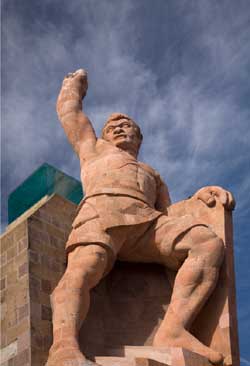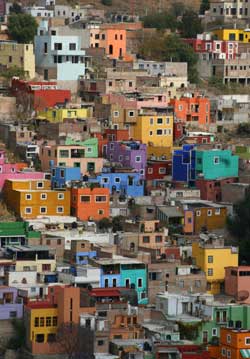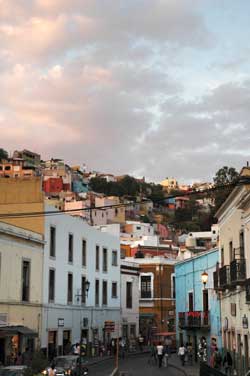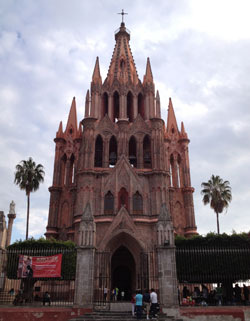GUANAJUATO, UNESCO WORLD HERITAGE SITEA Colonial Jewel

HISTORY
The city of Guanajuato was home to the indigenous Tarasco and Chichimeca peoples, who called the place Quanaxhuato, meaning "hilly place of frogs."
In the mid 1500s, the silver mother lode was discovered, setting off a silver and gold rush that would make Guanajuato one of New Spain's most important cities. In 1570, the town of Santa Fe de Guanajuato was chartered, and in 1741 King Philip V granted the city the title of Most Noble and Loyal City of Santa Fe and Real de Minas de Guanajuato.
Guanajuato played a central role in Mexican Independence. On September 28, 1810, Hidalgo and his army took the city, waging the first battle of the insurgency known as the Taking of the Alhóndiga de Granaditas. A miner known as El Pípila, carrying a massive stone on his back, rammed the doors of the Alhóndiga to breach the Spanish defense.
GEOGRAPHY AND CLIMATE

Students are advised to bring an umbrella if they come during the summer rainy season, and a jacket for chilly nights, which are a given during winter but are also frequent at other times of the year.
Guanajuato Attractions
Guanajuato, the capital of the state known as Mexico's "Cradle of Independence," is visited by large numbers of Mexican and foreign tourists every year. Among the most popular sites are:
- Teatro Juárez
- Considered one of the most beautiful theaters in Mexico.
- Teatro Principal
- Venue of many cultural events including events in the Festival Internacional Cervantino.
- Universidad de Guanajuato
- The main building of which was built in the mid 20th century and which is front and center on the new Mexican 1000 peso bill.
- Museo de la Alhóndiga de Granaditas
- Site of the first battle for Mexico independence on September 28, 1810; now a museum featuring historical documents, paintings and various other historical objects.
- Museo de las Momias
- A museum exhibiting mummified bodies perfectly preserved because of the unusual composition of the cemetery soil.
Just strolling the streets, you will stumble on museums, churches, plazas and gardens where you can relax and enjoy art and culture.
We recommend a late afternoon walk around the city following by a sunset ride up the funicular tram to the Pípila, where the view of the city will wrap you in its magic.
Many of the city's mines continue operating to this day, such as the mines of Rayas, San Ramón and Cubo. Some others no longer produce but are rather open to the public to explore, including Valenciana and Nopal, offering tours that provide a glimpse of the miner's experience!
GETTING TO GUANAJUATO
 By Air
By Air

Guanajuato International Airport (IATA: BJX) is located in the city of Silao, just 25 minutes from Guanajuato.
Direct domestic flights are available to and from Mexico City, Tijuana, Monterrey and Cancun.
Direct international flights are available to and from the hubs of San Francisco, Dallas/Fort Worth, Atlanta, Los Angeles and Houston.
We provide shuttle service from the airport to the city of Guanajuato.
Ground Transportation
Several bus lines, including Primera Plus and ETN, serve the Mexico City - Guanajuato route. There are frequent direct departures from the North Central Bus Station in Mexico City to Guanajuato, and the trip takes 5 hours.
CITIES NEAR GUANAJUATO

- San Miguel de Allende
- One of the most important things to see here is the Parroquia de San Miguel Arcángel, which has become the symbol of the city. The church was built in the 18th century with a Baroque façade, which, in 1880, was replaced by a Neo-Gothic façade by master architect Ceferino Gutiérrez.
- Dolores Hidalgo
- Famous as the cradle of Mexican independence, as well as for its pottery and exotic flavors of ice cream.
- León
- One of the major industrial cities in the state, especially important in the manufacture of leather items, which are exported around the world.
- Irapuato
- A city which has seen major growth recently with the arrival of a number of different automotive companies.
